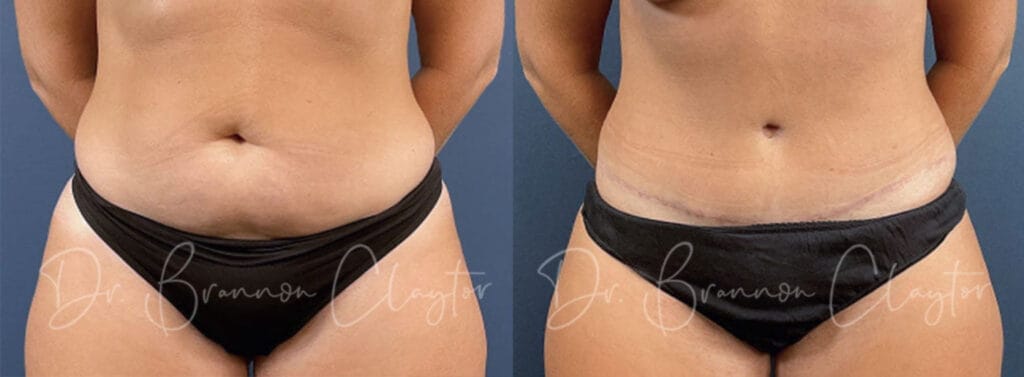Scarring After Plastic Surgery: Everything You Need to Know

When it comes to plastic surgery, scars are a fact of life! That’s why we embrace conversations about them. Starting with your initial consultation with Philadelphia plastic surgeon Dr. Brannon Claytor, you will learn about the ways we tailor care to achieve beautiful results—and a big part of that will be where we place your incisions, plus the after-care steps we will take to help your scars heal beautifully.
Below, learn about the scar healing process and what Dr. Claytor recommends for minimizing their appearance to maximize your results.

How fast do surgical scars heal?
Scars from plastic surgeries like tummy tuck or facelift continue to diminish in appearance for a full two years, but, importantly, scar tissue takes about 3 months to regain its strength. Furthermore, scars are only about halfway to their ultimate strength level at 6 weeks after surgery; this is when most patients are allowed to resume many activities and when we will likely clear you to get back to your routine, especially if you live a relatively sedentary lifestyle.
While it feels great to get back to normal life, understand that anything more than occasional light stress on your scars at this time could widen them, so, until they reach their full strength after about 3 months, it’s best to avoid any activity that might strain your healing tissues.
Scar maturation can vary based on the procedure, incision placement, and your unique anatomy, so be sure to ask your doctor specific questions you have about what you can and can’t safely do. For example, a facial procedure such as an eyelid lift will have a faster healing time and less restrictions than a body lifting procedure.
How to help your scar heal to near invisibility
The appearance of your scars have two components: elevation and color, or pigmentation. Achieving the most beautiful results with ultra-fine, near-invisible scars requires several methods to help the scars to heal both flat and as close to your natural skin color as possible. In addition to following your plastic surgeon’s advice for physical activity limits, you can help your scars heal with a few proven methods:
Choose a surgeon who uses carefully-placed incisions
Board-certified plastic surgeons are extensively trained and experienced in surgical methods that lead to aesthetically pleasing outcomes, and scar placement is a key part of this. Plastic surgeons should place incisions in areas where the least natural tension will be placed on the healing scar, helping it to heal normally.
Incorporate a scar gel
A scar gel such as Strataderm™, which we sell in our office, or Mederma, which is available OTC at pharmacies, can be applied routinely to help minimize the appearance of scars.
Prevent hyperpigmented scars with sun protection
It’s critical to protect healing scars from sun exposure, which darkens them: pigment develops during sun exposure as the body’s reaction to protect itself from the ultraviolet (UV) rays.
Use sunscreen, hats, umbrellas, and clothing to protect healing incisions (avoid relying on sunscreen alone). In addition, you may want to consider wearing white, yellow, cream, or other light-colored bathing suits and clothing that deflect the UV light away, as dark colors like black and brown pull the light in.
Practice scar massage if instructed by your surgeon
Some plastic surgeons may recommend that certain patients practice scar massage once their scar reaches a certain point in maturity. When scar massage is called for—and each patient should ask their doctor if scar massage is appropriate for them—it can help to break up hard, raised scar tissue.
Treat early post-surgical scars with microneedling
In addition to the above measures, Dr. Claytor uses either microneedling or Morpheus8 RF microneedling to induce collagen remodeling, helping to improve scars’ appearance by making them flatter and less visible.
Previously, most surgeons believed that it was necessary to wait a full year after surgery before using microneedling to improve surgical scars’ appearance. But Dr. Claytor recently published a study in the journal Plastic And Reconstructive Surgery which found that patients who started a microneedling regimen earlier—as early as 6 weeks after surgery, once the initial healing process was complete—saw significant scar improvement at the four-month mark.
As a surgeon who is well-known for his natural-looking deep plane facelift results, Dr. Claytor is constantly working to improve methods to minimize scar appearance and promote quicker scar maturation. While scars are placed inconspicuously, scar care is still critical to achieving the finest possible scars.
Dr. Claytor’s study found that patients who started a microneedling just 6 weeks after surgery saw significant scar improvement at the four-month mark.
Scar revision surgery
In more severe cases where a scar has healed irregularly, you may decide to consult with a board-certified plastic surgeon about scar revision surgery. Revision surgery is not usually able to create a scar-free result, but a skilled surgeon may be able to improve the scar’s appearance by removing scar tissue and carefully suturing the new incision with techniques to help create a fine scar that heals to be barely perceptible. Of course, it is also key to incorporate scar care during recovery from scar revision surgery.
About Philadelphia plastic surgeon Dr. Brannon ClaytorDr. Claytor is a board-certified plastic surgeon with many years of plastic surgery experience. He has published numerous articles over his career to advance the science and artistry of aesthetic medicine, and he is committed to helping patients see their dream results safely. Dr. Claytor and the outstanding medical team at the Claytor Noone Plastic Surgery invite you to call our office at 610.527.4833 or contact us online to schedule a consultation today!
